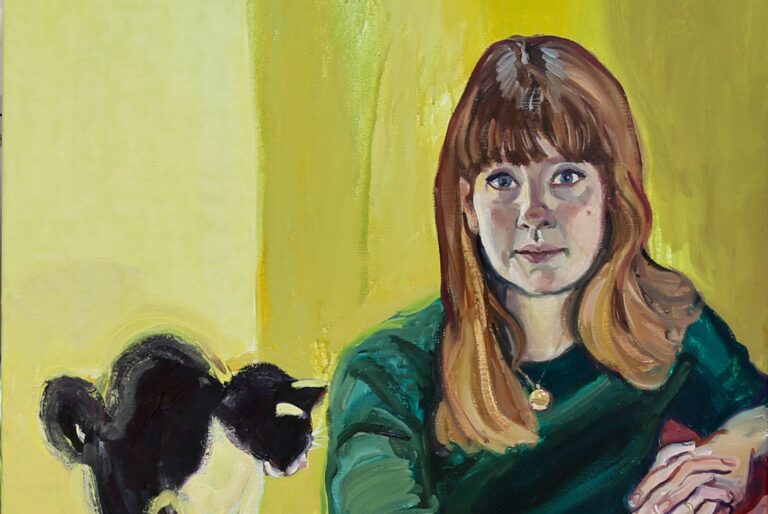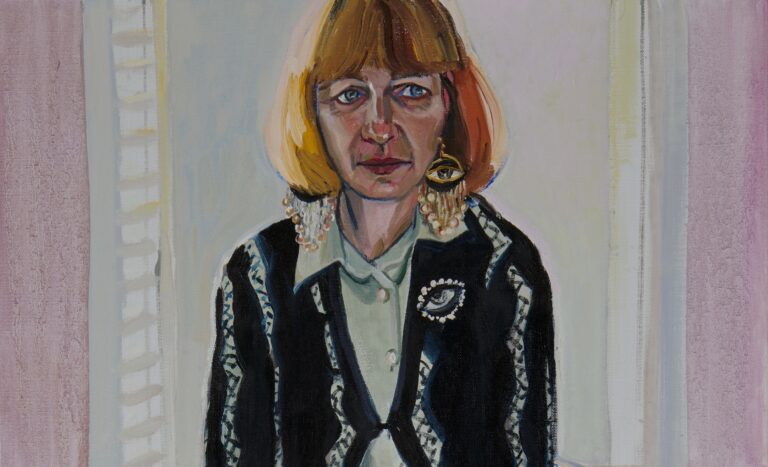I have always looked at people as the subjects of art, but I arrived at portraits late in my journey as an artist. The catalyst was a catalogue from a 2006 exhibition at the Met, Glitter and Doom, where I rediscovered German art from the interwar period, and especially the work of Otto Dix and the New Objectivity. Maybe it was because my technical training at art school did not include portraiture that I was so sensitive to the raw humanity of these paintings.
At any rate, lack of academic background has determined my own approach to portraits. Formally, I do not think of a portrait any differently to, for instance, a landscape. I judge the success of a portrait foremost as a painting, or a work of art even. What I mean by this is that rules can only take you so far: a technically accomplished portrait does not necessarily make an interesting painting.
And so, I do not have any strict rules about portraits to pass on. For that, and for so much more, I can recommend Robert Henry’s book, The Art Spirit, which has been invaluable to me. I can only share what I find helpful and hopefully provide some tools to help a painter discover and pursue what they value in a portrait.
Let’s begin with the obvious: unless you are painting a commission, there needs to be a purpose, a particular vision behind any portrait. Wanting to make a portrait is one thing – but ask yourself, why this portrait. Such a goal could be to communicate the aura of an individual or a particular emotion, to capture a narrative or a scene that you find compelling, or, if it is the painting itself you are more interested in, to explore a certain colour or composition.
In the course of a portrait you will find many things to engage you, but setting out with a vision like this will give you direction in the decisions you make. You will actually feel more bold and spontaneous when the practical business of making the portrait begins, and will hopefully produce a painting that speaks clearly and has its own recognisable character.
If what you are trying to capture is abstract, such as a mood or feeling, then you need to begin creating a bridge between this energy and the physical reality of the painting. The first practical step is figuring out a composition. Preliminary drawings help you to do this.
Ask yourself, what will the sitter be doing? To what extent will the sitter be engaging with the painter? Will there be any other elements in the painting – chairs, for example – and how will the sitter be interacting with them in the compostion? I usually discuss all of these questions with the sitter, as I feel that more of the sitter’s personality will come across if they are presenting themselves in a way they have chosen.
Look at the scene and begin to refine it before committing anything to paper. The composition is born in your eye; it is an act of visual interpretation. By all means think about the size and dimensions of the canvas you will use, and what sort of negative space you want around the figure. Remember that negative space is as important as positive space in the painting. While you may want the figure to be the source of energy in the painting, background and figure must nonetheless work together in a strong composition (later, I usually tie the two together by using elements of the same colour and tone in both).
I try to paint from life as much as I can, but having a sitter is a luxury and realistically photographs are often a necessary part of the process. I normally take photographs while I am drawing, so that I can refer back to both the objective reality of the composition as well as my interpretation of it.
The medium you choose for preliminary drawings will often determine the character of the portrait. Charcoal enables a style that is gestural and emotive – think of Frank Auerbach. A brush and thin paint allows a quick map of the composition, gives a sense of volume, and encourages a free, loose style, such as that of Richard Diebenkorn or Avigdor Arikha. Pencil drawings are safe and precise, as shown by Ingres. And, my favourite, a pen drawing forces you to be bold, lyrical, and to capture the essence of your subject in a single line. Matisse and Hockney are masters of this style.
My preference for the pen is reflected in my paintings by outline. Maybe due to my love of drawing and printmaking, outline is integral to the way I paint people; I even see my style as something like drawing with paint. In this I have taken inspiration from Van Gogh, Suzanne Valadon, Alice Neel, Max Beckmann, and many others. I feel that outline gives the figure a sense of solidity, as well as giving your painting a sense of confidence: you decide where the person ends and the background begins.
If you are interested in exploring a style like this, one preliminary practice I can recommend is to draw the same pose twice, first with brush and charcoal to feel out the shapes and spaces, and then with pen, to take control of the composition with a strong line.
Pallet is another area of very personal ideas. Some like a limited pallet throughout their work; I prefer one that is as diverse as possible, to make each painting more individual. On a practical note, avoid a sloppy pallet and dirty brushes, as these can take over your painting.
Incidentally, you can practice working with colours anywhere. When I see something that looks like a subject to paint, I mix the colours in my head. This way you can become more instinctive when you are actually painting.
Now, the last question you have to deal with in a portrait, as with any painting, is when is it complete? One way of addressing this is by thinking back to your initial vision – have you said what you wanted to say? It is often more complicated than this, of course. Sometimes you end up saying something different which you quite like.
Thus, you have to be aware of the moment when, as Alfred Stieglitz notes, “in struggling too hard for perfection you know that you may lose the very glimmer of life, the very spirit of the thing, that exists at a particular point in what you have done.” When you are trying to capture the essence of a person in a portrait, it is essential to recognise this glimmer of life.
Something I want to emphasise perhaps above any of this advice, though, is how much of the work of a portrait painter can be done by drawing people out in the world. This is why when I began painting portraits seriously I already felt comfortable. Drawing not only teaches you to observe but develops your intuition for representing the inner life of a person. Even if you don’t have a sketchbook, you can still draw people with your eyes: follow the contours of their face, their expression, their body language.
And finally, as is often said but still bears repeating: take yourself out of your comfort zone occasionally. Paint studies in a different format, or with different sized brushes. You never know what you might discover, and at any rate you will find a fresh perspective on even your oldest habits.
Published in Artists & Illustrators magazine, June 2016




